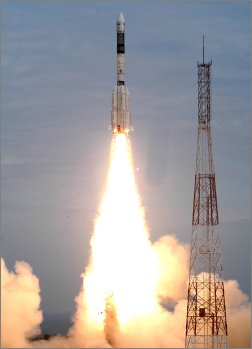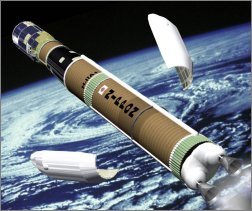European and US space industries are facing tougher competition from emerging Asian economies, but national ambitions may keep the tigers caged
Asia’s growing economies are poised to combine their lower labour costs with advancing spacecraft and launcher know-how to threaten the historical market leaders in Europe and the USA.
|
| India's GSLV Mk 1 can place 2t in geosynchronous orbit |
Coverage of Beijing’s manned spaceflight successes in 2003 and 2005 was pervasive, but China is not seen as the number one competitive threat by Asia watchers. China launched its first satellite in 1970, but the first commercial Long March launch did not come until 1990. In the 16 years since then, 27 foreign-made satellites have been launched by China, a rate that pales in comparison with just one of the US launch providers, International Launch Services, which has made 58 commercial, non-government Atlas launches during the same period.
“China has not been promoting its capabilities as much [as other countries],” says Netherlands’ International Institute for Asian Studies affiliated fellow David Soo. “[Europe and the USA] should be more concerned about India. It has been very aggressive in its marketing of launchers and satellites.”
Revenues this financial year for Antrix, the commercial arm of the Delhi government’s Indian Space Research Organisation (ISRO), are expected to be about Rp3.6 billion ($82 million). The company has already accomplished two successful commercial flights using ISRO’s Polar Satellite Launch Vehicle (PSLV). The two launches orbited four piggy-back satellites from Belgium, Germany and South Korea.
The PSLV, able to put 1.2t (2,640lb) into a polar Sun-synchronous orbit, will also be used for India’s first foreign commercial single-satellite launch. For $10 million, Antrix is launching the 350kg Italian science satellite, Agile, in the second quarter of this year.
Antrix intends to expand its range of launch services by commercialising the follow-on to India’s Geosynchronous Satellite Launch Vehicle (GSLV) Mk1, which can place 2t in geosynchronous transfer orbit (GTO). They are the 2.5t-to-GTO GSLV Mk2, scheduled to make its maiden flight in 2007, and the 4t-to-GTO Mk3 expected to fly in 2008. All launches will be from ISRO’s Satish Dhawan Space Centre on Sriharikota island.
The 3,100kg Insat-4A C- and Ku-band communications satellite, the fourth generation of indigenous Insat spacecraft designed and built by ISRO’s Bangalore-based Satellite Centre, was launched in December by Europe’s Ariane 5. Antrix expects the next-generation Insat-4A to generate Rp400 million a year from communication services.
The Bangalore-based company has been active in marketing components, hardware and subsystems to satellite fabricators in Europe, Japan and the USA. An alliance to market 2/3t-class satellites based on the Insat 2K and 3K buses, signed by Antrix and EADS Astrium in June last year, has achieved its first success, and will supply the W2M satellite to Europe’s Eutelsat Communications for launch in 2008. EADS will be prime contractor and supply the Ku-band communications payload, while ISRO will build, integrate and test the 3t, 4kW satellite.
Despite Indian leadership in this sector, Soo is sure China is not too far behind, “Once China is more confident, once they have mastered the intricacies of satellite technology and making them more reliable, it will be just a matter of time before they offer a complete satellite.”
China’s challenge
|
| By 2008, Japan plans to use its H-2B to lift the HTV cargo craft to resupply the ISS |
SAST, meanwhile, develops launch vehicles and satellites. Its first spacecraft were the CK-1s, which defence analysts in the 1970s labelled electronic intelligence spacecraft. Since then SAST has built meteorological and Earth science satellites. The two Chinese companies jointly produce the FY-2 weather satellite.
More significantly, the companies produce China’s Shenzhou manned spacecraft. CAST is responsible for the overall design, most of the subsystems, the re-entry and orbital modules and final integration. SAST is responsible for the propulsion module, power and communication subsystems and the docking mechanism.
New Chinese entries into the space market are the Heilongjiang-based Harbin Institute of Technology, Tsinghua University and the China Academy of Sciences. Harbin Institute has developed the SY-1 small Earth-observation satellite, while the Beijing-based Academy has produced the CX-1 store-and-forward communications satellite. Tsinghua University has developed its Naxing-1 nanosat and the PS-1/2 small satellites based on its Tsinghua-1 spacecraft developed with the UK’s University of Surrey.
China’s satellite manufacturing sector has made significant progress in recent years and can now produce more than 10 satellites a year. With the DFH-4 communications satellite, FY-3 weather satellite and Shenzhou manned spacecraft, the gap between Chinese and Western technology has shrunk to about 10 years.
China is, however, still buying some foreign satellites. Last month China Satellite Communications signed a deal with Franco-Italian company Alcatel Alenia Space for the ChinaSat 6B, which will be launched by China’s state-owned China Great Wall Industry.
Japan, despite its world-leading electronics industry, has long been a market for Western satellite expertise. “In Japan there is good technology in niche areas, but it does not have what is needed for a complete satellite and it has relied on the USA,” says Pierre Lionnet, head of strategy, technology and economic affairs for Europe’s satellite industry association, ASD-Eurospace. In November, Mitsubishi Electric became the first Japanese company to enter the commercial satellite market, beating international competition to win the contract for Superbird 7 from Japan’s Space Communications.
While its astronauts fly on NASA’s Space Shuttle and government satellites have been launched successfully, Japanese rockets have been too unreliable for commercial use – despite the fact that Japan launched its first satellite in 1972. It does not help that Tokyo has cut its space programme budget from $1.9 billion in 1999 to $1.5 billion last year.
The challenge is to complete the restructuring begun in 2003, when the Japan Aerospace Exploration Agency (JAXA) was created by merging the Institute of Space and Astronomical Sciences (ISAS), National Aerospace Laboratory (NAL) and National Space Development Agency (NASDA). The move has not been seen as beneficial. “ISAS was world famous as the most cost-effective space science research centre in the world,” says Azabu University’s professor of space economics Patrick Collins. “Unfortunately JAXA was created for bureaucratic convenience and it is, predictably, ruining ISAS.”
Return to flight
The failure of the sixth Mitsubishi Heavy Industries H-2A rocket, which had to be destroyed shortly after its launch in November 2003, was a major setback for Japan’s plans to commercialise the booster. But, on 24 January this year, the H-2A returned to flight with the successful launch of the 4,000kg Advanced Land Observing Satellite.
Tokyo now has an ambitious plan to launch satellites on 9, 15 and 18 February. If this triple launch is achieved, it will boost the beleaguered agency’s hopes of developing the H-2B, planned for launch in 2008. With a payload of up to 8t, the H-2B is designed to lift the H-2 Transfer Vehicle (HTV), a cargo spacecraft to supply the International Space Station. But the European Space Agency has a budget almost double that of JAXA and even its ISS resupply spacecraft, the Automated Transfer Vehicle (ATV), has been delayed several times.
Flying tigers
|
| Commercial and government satellite launches 2004 |
The country’s links with Russia continue to grow and in January the Korean Aerospace Research Institute (KARI), which oversees the national space programme, announced plans to build and test launch vehicles derived from Khrunichev Space Center’s developmental Angara.
KARI has a three-stage development plan. Stage one will see construction of 10 100kg-to-LEO Korea Space Launch Vehicle (KSLV)-1 test boosters, including one for a micro-satellite launch in 2007. In stage two, the 1t-to-LEO KSLV-2 will be developed by 2010; stage three aims to have the 1.5t-to-LEO KSLV-3 operational by 2015. KARI will launch the vehicles from a facility being built on Venarodo Island in the Sea of Japan, again with Russian help.
In a similar vein, South Korea’s strategy for satellites has been to partner Western companies. KARI worked with Lockheed Martin to build its three Koreasat telecommunication satellites, the last of which was launched in 1999 by Arianespace. That same year, an Orbital Sciences’ Taurus launched KARI’s 510kg Korea Multi-Purpose Satellite (Kompsat)-1. This year its successor, Kompsat-2, will be launched by a Eurockot Rockot.
Closer to South Korea’s goal of a national satellite manufacturing capability, Kompsat-2 was built with components and assistance from EADS Astrium and KARI turned to EADS again for its latest satellite, Coms, which will use Astrium’s Eurostar E3000 platform. With a launch mass of 2.4t and 2.4kW of power, it will have three payloads; one to monitor weather; one for ocean and Earth observation; and one KARI-supplied three-beam Ka-band communications system.
Other Asian satellite hopefuls include Indonesia, Malaysia and Thailand. Indonesia, which wants to use satellites for its telecommunications needs, has worked with Berlin Technical University on building a spacecraft. Malaysia is equally ambitious and wants to build its own satellites. So does Singapore, and its Nanyang University of Technology is developing technologies at its Satellite Engineering Centre. Singapore has also arranged to use ISRO facilities for platform development.
Working with Guildford, UK-based Surrey Satellite Technology, the Vietnamese government is interested in creating a satellite design centre, but not in manufacturing. This month will also see the state-owned Vietnam Posts and Telecommunications Corporation formally invite bidders for its $200 million Vinasat satellite.
Thailand is also hoping to benefit from Western expertise, having contracted EADS Astrium to build a satellite. Bangkok aims to learn from the experience and develop its own satellite technology centre. Finally, Taiwan is nearing completion of a 15-year space programme. Managed by its National Space Organisation, the goal was to have three satellites in orbit by 2002, at an estimated cost of $545 million. So far it has launched only two.
The first, Rocsat-1, was built by TRW and launched by Lockheed Athena in January 1999. The 750kg Rocsat-2, an Earth observation satellite launched in May 2004, was designed by EADS Astrium, but assembled in Taiwan. Taipei has revealed it will be used for military reconnaissance. Under its Rocsat-3 programme, the country plans eight low-altitude satellites to study the Earth’s ionosphere and climate. Nothing has been heard since 2003 of plans to launch a domestically developed series of 10kg satellites called Yamsat.
Military priority
In a region with many national efforts on small budgets yet with similar economic development needs, it would seem logical to combine efforts. An Association of South East Asian Nations Space Development Agency has been formed, but so far led to nothing. Equally moribund are the initiatives started by Japan and China. The problem, according to Soo, is that Japan’s Asia Pacific Space Agency Forum and China’s Asian-Pacific Multilateral Space Technology Cooperation Symposiums compete in selling the two country’s technology while encouraging collaboration on expensive projects, which other Asian nations cannot afford either.
Another major factor is security. As Soo puts it: “It’s understated, but military use [of these satellites] is very much in the thoughts of the Asian countries – looking at what your neighbour is doing.” The reality of Asian space activities is that a mixture of national pride, the need to monitor neighbours’ military activities and economic competitiveness are combining to give, for the time being, an opportunity greater than the threat they represent to the traditional market leaders.
ROB COPPINGER / LONDON
Source: Flight International


























